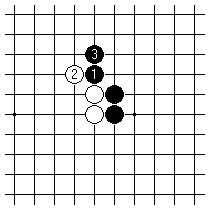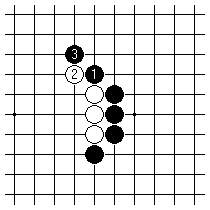

After you play hane, what comes next?

You may assume that the thing is to extend with 3 after 1 and 2. If so, you assume wrong.

From a doctrinal point of view you should be following one of these two patterns. On the left we have double hane, a power play. On the right we have a connection of "staircase" type.
Doctrinal? After all, the extension in the first diagram can be seen in standard opening sequences. It's some sort of ideological mistake?
Well, yes, it is. Let me try to explain. Go players operate with a concept of "shape". This corresponds pretty much to what chess players have with positional play. In shogi, too, there are basic principles which help you avoid getting your generals back-to-front, and so on. The body of shape "doctrine" in Go conditions how strong players think. It doesn't completely rule the roost. But in a discussion between a 4 dan player and a 4 kyu player, for example, the 4 dan is going to object to a large number of the 4 kyu's suggestions on grounds of shape. If you want to become strong at Go you have to understand the struggle for good shape on the board; and also of course when to switch away from that point of view and use accurate analysis.
So, simply extending isn't perfect shape. It leaves a cutting point. The argument is that the next play should either be hane again, which when it succeeds bends the opponent's line of stones back through 90 degrees. Or it should be the solid connection, a tight play to hold firm in this part of the board.
The Japanese way of Go instruction isn't very explicit. It can rely on remarks thrown out like "A will never really improve until he understands X". Often enough X isn't some particular point about shape (there are very many) but the attitude behind it. Unlike a football manager being interviewed, the highly numerate Japanese aren't likely to talk about stones giving 110% effort. Think of X as this concept, though. You're there playing Go, and if your stones are slacking in their effects on the board it's entirely your responsibility. Go exhibits this burden in a particularly pure form, because a stone that is falling down on the job just sits there reproaching you.

So, it's double hane, when appropriate, or wonder why you're playing Go if you hold back half the time for unspecified reasons. In this position Black plays the second hane without hesitation. White's three stones are down to three liberties after the first hane play, and the correct way to exploit this is the second hane.
No, please don't come back with the comment that there must be positions in which that isn't true. The sheer richness of possibilities on the Go board means that's bound to be the case. Just don't let me catch you extending a position where double hane is best, with some lame excuse about thinking it looks dangerous. I remember Gandalf was good on being "dangerous".
First published 18 July 2000 as On Your Side on MindZine,
Go Learning
© Charles Matthews 2000.